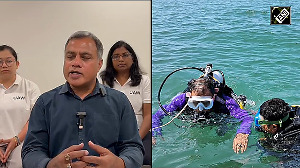The time to clean up the Ganga is now and the livehood and future of millions of people depend on it, says geologist Dr Nitish Priyadarshi.
The National Ganga River Basin Authority recently requested the Supreme Court for another ten years time, promising to clean up Ganges by 2020.
Much polluted water has flown under the bridge since the Central Ganga Authority was formed in 1985 under the Prime Minister Rajiv Gandhi, promulgating the Ganga Action Plan.
At the 1981 session of the Indian Science Congress in Varanasi, scientists expressed concern at the growing pollution in the river Ganga in presence of the then Prime Minister Indira Gandhi who inaugurated the session. At her instance, Dr M S Swaminathan, then member of the Planning Commission asked the Central Board for Preventation and Control of Water Pollution, New Delhi to conduct studies on the state of the river Ganga.
In collaboration with the state pollution control boards of Uttar Pradesh, Bihar and Bengal and the Centre for Study of Man and Environment, Kolkata studies were conducted on the 'sources' of pollution including all human activities, land use pattern and water quality of the river at selected sites during 1981-82 and report entitled "Basin, sub-basin inventory of water pollution in the Ganga basin part-II" was published in 1984. According to this report sewage of 27 class I cities and towns and effluents from 137 major industries were the main source of pollution of the river in addition to cremation.
In spite of several announcements and promises by different governments, the Ganga still remains polluted. The World Bank has stepped forward with an offer of $1 billion (about Rs 4,500 crore) to help save the Ganga. Funds are sufficient but it is lack of political will and bureaucratic apathy that stands in the way.
This river has become a dumping ground for domestic and industrial wastes. The uninterrupted release of toxic materials into the river not only affected the aquatic life of this river but also turned these natural sources of water virtually into a nullah carrying all urban waste.
There has been a steady deterioration in the quality of water of Indian rivers over several decades. India's 14 major, 55 minor and several hundred small rivers receive millions of litres of sewage, industrial and agricultural wastes. Most of these rivers have been rendered to the level of sewage flowing drains. There are serious water quality problems in the cities, towns and villages using these waters. Water borne diseases are rampant, fisheries are on decline, and even cattle are not spared from the onslaught of pollution.
According to World Wide Fund for Nature, five rivers in Asia serving over 870 million people are among the most threatened in the world, as dams, water extraction and climate change all take their toll.
The Ganges, Indus, Yangtze, Salween-Nu and Mekong-Lancang rivers make up half of the WWF's top ten most threatened river basins.
The Ganga has been held in high esteem since time immemorial and Hindus from all over the world cherish the idea of a holy dip in the river under the faith that by doing so they will get rid of their sins of life. More than 400 million people live along the Ganges River. An estimated 2,000,000 persons ritually bathe daily in the river.
Historically also, the Ganga is the most important river of the country and beyond doubt is closely connected with the history of civilization as can be noticed from the location of the ancient cities of Hardwar, Prayag, Kashi and Patliputra at its banks.
To millions of people it is sustainer of life through multitude of canal system and irrigation of the wasting load. Hundreds of the villages and even the big cities depend for their drinking water on this river. It is believed, a fact which has also been observed, that the water of Ganga never decays even for months and years when water of other rivers and agencies begins to develop bacteria and fungi within a couple of days. This self purification characteristic of Ganga is the key to the holiness and sanctity of its water.
During the past three decades, the country's explosive growth (at nearly 1.2 billion people, India's population is second only to China's), industrialisation and rapid urbanisation have put unyielding pressure on the sacred stream.
The Ganga, the most sacred of rivers for Hindus, has become polluted for some years now. But a recent study by Uttarakhand Environment Conservation and Pollution Control Board says that the level of pollution in the holy river has reached alarming proportions.
Things have come to such a pass that the Ganga water is at present not fit just for drinking and bathing but has become unusable even for agricultural purposes.
As per the UECPCB study, while the level of coliform present in water should be below 50 for drinking purposes, less than 500 for bathing and below 5,000 for agricultural use -- the present level of coliform in Ganga at Haridwar has reached 5,500.
In Varanasi, India's most sacred city, the coliform bacterial count is at least 3,000 times higher than the standard established as safe by the World Health Organisation. Coliform are rod-shaped bacteria that are normally found in the colons of humans and animals and become a serious contaminant when found in the food or water supply.
A study by Environmental Biology Laboratory, Department of Zoology, Patna University, showed the presence of mercury in the Ganga river in Varanasi city. According to the study, annual mean concentration of mercury in the river water was 0.00023 ppm (parts per million). The concentration ranged from NT (not traceable) to 0.00191 ppm.
A study done by Indian Toxicological Research Centre, Lucknow during 1986-1992 showed maximum annual concentration of mercury in the Ganga river water at Rishikesh, Allahabad district and Dakshineswar as 0.081, 0.043 and 0.012 ppb (parts per billion) respectively.
Monitoring of the Ganga from Rishikesh to Varanasi indicated that Kannauj to Kanpur and Varanasi are the most polluted stretches of the river Ganga. Analysis of upstream and down stream water and sediment revealed a 10-fold increase in chromium level.
The tannery industry mushrooming in north India has converted the river into a dumping ground. The tanning industry discharges different types of waste into the environment, primarily in the form of liquid effluents containing organic matters, chromium, sulphide ammonium and other salts. As per an estimate, about 80-90 percent of the tanneries use chromium as a tanning agent.
Of this, the hides take up only 50-70 percent while the rest is discharged as effluent. Pollution becomes acute when tanneries are concentrated in clusters in a small area like Kanpur. Consequently, the leather-tanning sector is included in the Red category of industries due to the potential adverse environmental impact caused by tannery wastes.
What hope is there for the Ganga? There is in the River Thames in England. The Thames, which remained polluted for many years in the wake of the Industrial Revolution and rapid urbanisation is now pristinely clean. It is just a matter of having the will and working together.
Indeed we have no choice but to work together to salvage the Ganga, if we expected to be bestowed with salvation by this river from the heavens any longer.
Dr Nitish Priyadarshi is a geologist and lecturer in the Department of Environment and Water Management, Ranchi University.









 © 2025
© 2025